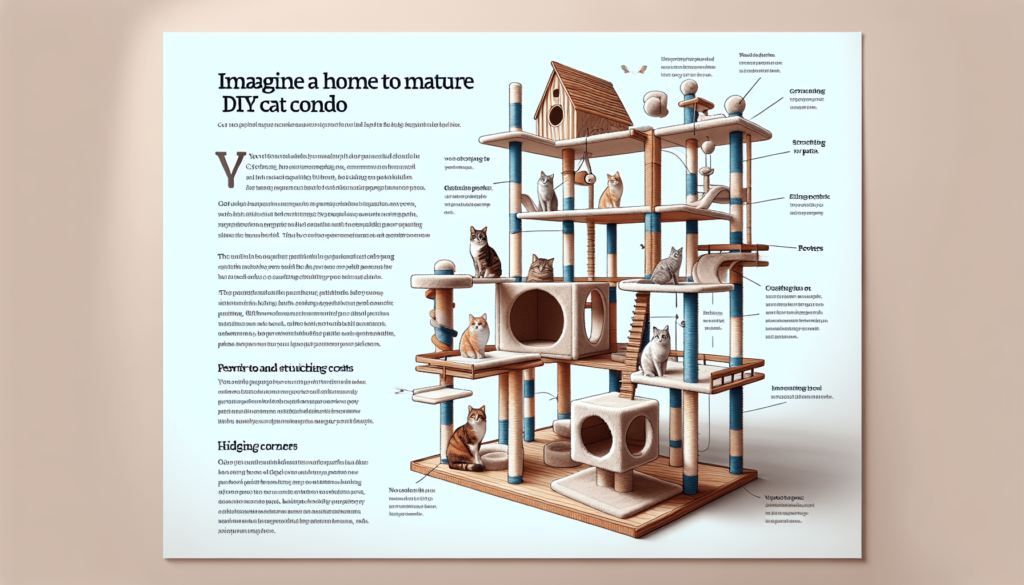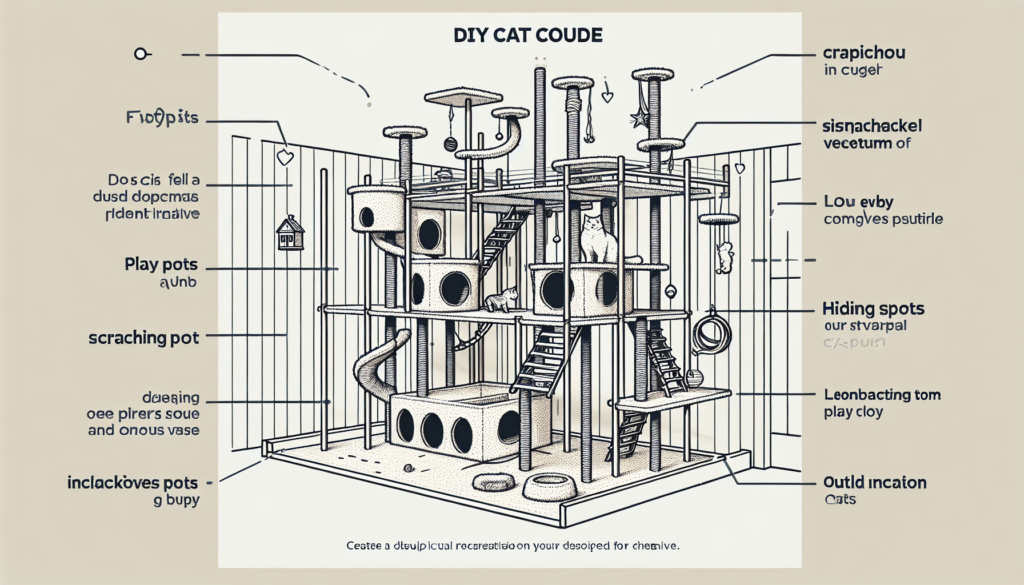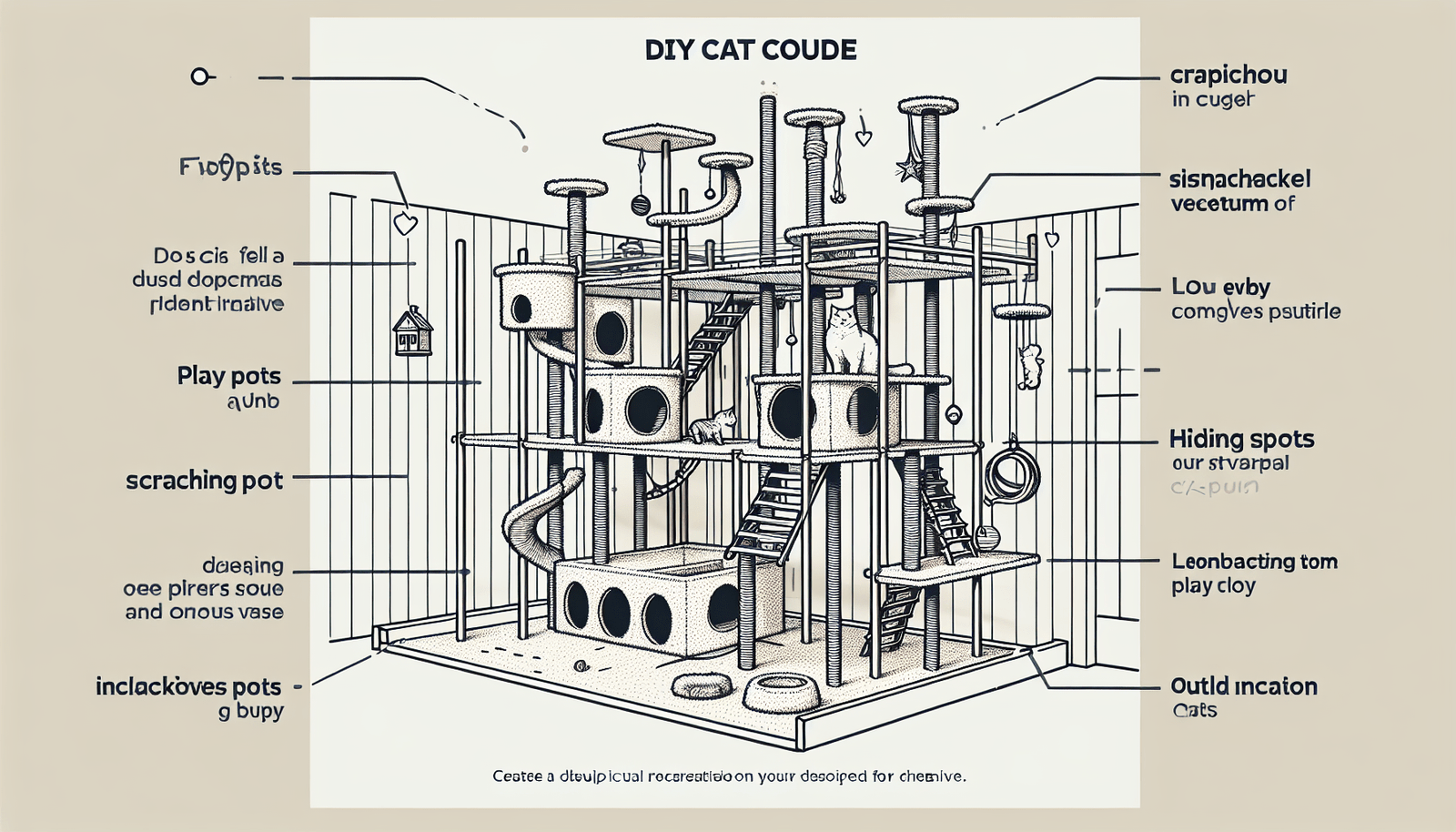If you’re a cat lover and looking for a fun, creative project to keep you busy, look no further! In this ultimate guide, you’ll learn everything you need to know about building your very own DIY cat condo. From materials and tools to step-by-step instructions, we’ve got you covered. Get ready to unleash your inner handyman and create a cozy, personalized space for your feline friend to lounge and play!
Choosing the Right Materials
When it comes to building a cat condo, selecting the right materials is crucial. You want to ensure that the materials you choose are both sturdy and safe for your furry friend. Look for durable options that can withstand the weight and activity of your cat, such as solid wood or plywood.
Considering the size and weight of your cat is also important. If you have a larger cat, you’ll need to choose materials that can support their weight without compromising the stability of the condo. On the other hand, if you have a smaller cat, you may be able to work with lighter materials without sacrificing durability.
Easy cleaning is another factor to consider in material selection. Cats are notorious for shedding and accidents, so you want to choose materials that can be easily wiped clean or vacuumed. Options like faux leather or machine-washable fabrics can be a great choice in this regard.
Lastly, it’s essential to opt for non-toxic materials. Cats are known for their curious nature and tendency to chew on things, so you want to make sure the materials you use are safe for them. Avoid any materials that may contain harmful chemicals or toxins.
Designing Your Cat Condo
Now that you have chosen the materials, it’s time to design your cat condo. Consider the size and number of levels you want in the condo. Think about the available space in your home and the preferences of your cat. Cats love to climb and explore, so having multiple levels can provide them with endless entertainment.
Plan the layout and structure of the condo carefully. You’ll want to ensure that there’s enough space for your cat to move around comfortably. Additionally, consider how the condo will fit in your home and whether it will be against a wall or freestanding.
Incorporating scratching posts and platforms is essential for any cat condo design. Cats need to scratch to keep their claws healthy and to mark their territory. Adding scratching posts at different heights and platforms for them to jump onto can satisfy their natural instincts.
Don’t forget to add cozy sleeping areas to your cat condo. Cats love to sleep in snug, enclosed spaces. You can include boxes or tubes as additional sleeping areas, and provide soft cushions or blankets for comfort. Place these sleeping areas in quiet and elevated spots, where your cat can retreat for some relaxation.
To keep your cat mentally stimulated and entertained, include interactive toys and activities. Hanging toys or balls can provide endless fun and exercise. Climbing walls or ramps can offer a new challenge and help your cat stay active. You can even attach feathers or strings to engage their hunting instincts. Don’t forget to sprinkle some catnip or treats to entice them and keep them engaged.

Gathering the Necessary Tools
Before you start building your cat condo, gather the necessary tools. You’ll need a measuring tape to accurately measure your materials and plan your design. A pencil and paper will come in handy for sketching out your ideas and making notes.
Having a power drill and screws is essential for assembling the frame of your cat condo. This will ensure that the structure is secure and stable. A saw and sandpaper will be necessary for cutting and shaping the materials. Make sure the edges are smooth to prevent any potential injuries.
To attach the materials securely, you’ll need a staple gun and staples. This will be used when covering the condo with carpet or sisal rope. Having these tools will make the process much easier and efficient.
Lastly, you’ll need the carpet or sisal rope itself for covering the cat condo. These materials will provide traction for your cat and give them a comfortable place to scratch. Choose a material that is durable and easy to clean.
Building the Base and Frame
To start building your cat condo, cut the baseboard to the desired size. This will be the foundation and determine the overall stability of the structure. Make sure it’s large enough for your cat to move comfortably, but not too big that it takes up too much space in your home.
Once you have the base ready, begin building the frame using wooden planks. Measure the height and width you want for your condo and cut the planks accordingly. Ensure that the frame is securely attached to the base to provide a strong foundation for the rest of the structure.
To reinforce the structure for stability, add additional support beams as needed. These beams will provide extra strength and prevent any wobbling or sagging. Make sure they are securely attached to both the base and the frame.

Adding Levels and Platforms
Now that the base and frame are complete, it’s time to add levels and platforms to your cat condo. These will provide vertical space for your cat to climb and explore.
Attach support beams at different heights to accommodate multiple levels. Consider the size and agility of your cat when determining the spacing between each level. Make sure there’s enough room for them to navigate without feeling cramped.
Secure the platforms onto the support beams, ensuring they are stable and secure. This will prevent any accidents or wobbling. You can use screws or brackets to attach them securely, depending on the materials you’re working with.
Cover the platforms with carpet or other materials that provide traction. Cats love to scratch and stretch, so having a textured surface will encourage them to use the platforms. Secure the covering with staples or other fasteners to ensure it stays in place.
Incorporating Scratching Posts
Scratching is a natural behavior for cats, so it’s crucial to include scratching posts in your cat condo. Choose the right material for the scratching posts, such as sisal rope or carpet. These materials offer excellent grip and can withstand the claws of your cat.
When it comes to height and placement, consider the preferences of your cat. Some cats prefer taller posts, while others like to scratch horizontally. Observe your cat’s behavior and place the scratching posts accordingly.
Secure the scratching posts firmly to the structure of the cat condo. This will prevent any wobbling or instability when your cat uses them. A sturdy attachment will ensure that the posts are safe and durable.
To further entice your cat to use the scratching posts, wrap them with sisal rope or carpet. Cats are drawn to the texture and feel of these materials, and it will encourage them to scratch and interact with the posts.
Creating Cozy Sleeping Areas
A cat condo wouldn’t be complete without cozy sleeping areas for your furry friend. Cats love to have their own little nooks where they can retreat and relax. Consider including enclosed spaces like boxes or tubes as additional sleeping areas.
To make these sleeping areas comfortable, add soft cushions or blankets. Your cat will appreciate the extra coziness and warmth. Make sure to use materials that are easy to clean, as cats shed and accidents can happen.
When placing the sleeping areas, choose quiet and elevated spots in the cat condo. Cats like to have a vantage point where they can observe their surroundings while feeling safe and secure. Consider placing these sleeping areas away from any noise or disturbances.
Including Interactive Toys and Activities
Keeping your cat mentally stimulated and engaged is essential for their overall well-being. Including interactive toys and activities in your cat condo is a great way to achieve this.
Install hanging toys or balls that your cat can swat at or bat around. These toys will provide entertainment and encourage exercise. Ensure that they are securely attached to the structure to avoid any accidents.
Incorporate climbing walls or ramps for your cat to explore. Cats love to climb and jump, and these elements will provide them with a new challenge. You can use materials like carpet or sisal rope to cover these surfaces, giving your cat traction as they explore.
Attach feathers or strings at various spots for your cat to play with. These dangling objects will trigger their hunting instincts and keep them engaged. Just make sure they are securely attached to prevent any choking hazards.
Using catnip or treats can also encourage your cat to interact with the toys and activities in the condo. These enticing scents will make playtime even more exciting for your furry friend.
Covering and Decorating Your Cat Condo
Now that the structure of your cat condo is complete, it’s time to cover and decorate it. Wrapping the condo with carpet or fabric provides a comfortable and inviting surface for your cat.
Choose a carpet or fabric that is durable and easy to clean. Cats may scratch or have accidents on the covering, so you want something that can withstand their behavior. Measure and cut the material to fit each section of the cat condo properly.
Secure the covering using a staple gun or other fasteners. This will ensure that it stays in place, even when your cat jumps or scratches on it. Make sure the covering is taut and doesn’t have any loose edges that could be a potential hazard.
Add decorative elements to give your cat condo a personal touch. You can attach ribbons or bows to different sections for a playful and whimsical look. Consider personalizing the condo with your cat’s name, either by embroidery or using adhesive letters.
Ensuring Safety Measures
As you build and maintain your cat condo, it’s essential to prioritize safety. Regularly inspect the structure for any sharp edges or loose parts that could harm your cat. Sand down any rough surfaces and tighten any screws or fasteners as needed.
To prevent any accidents, consider securing the cat condo to the wall or floor. This will ensure that it remains stable, even when your cat jumps or climbs on it. Use brackets, anchors, or other appropriate hardware to attach it securely.
Keeping toxic substances away from the cat condo is crucial for your cat’s safety. Cats are sensitive to many household products, so be mindful of what you store around the condo. Avoid placing the condo near any cleaning supplies or chemicals that could harm your cat.
Regularly inspect and maintain the structure of the cat condo. Cats can be rough on their furniture, so it’s important to check for any signs of wear and tear. Replace or repair any damaged parts promptly to maintain a safe and enjoyable environment for your cat.
Building your own DIY cat condo can be a rewarding and fun project. By choosing the right materials, designing a functional and engaging structure, and incorporating safety measures, you can create a comfortable and entertaining space for your beloved feline companion. So let your creativity and love for your cat guide you as you embark on this exciting endeavor!

